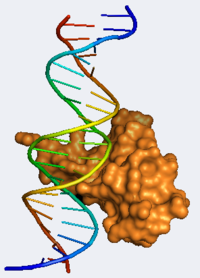Methyl CpG Binding Protein 2 (
MeCP2) is a transcriptional repressor that plays a critical role in mediating gene silencing. It binds the methylated BDNF
DNA sequence with exquisite specificity while recruiting repressor complexes which include chromatin-remodeling enzymes.
[1] MeCP2 has been found in most tissues but is highly concentrated in cortical neurons where it is believed to help modulate neuronal maturity and plasticity.
[2] It is believed to play a crucial role in synaptogenesis and in the maintenance of neuronal function.
[1] Of particular note, mutations within the MeCP2 gene are responsible for over 95% of cases of Rett Syndrome. Rett Syndrome (RTT) is an
autism spectrum neurodevelopmental disorder caused by the expression of mutant copies of the X-linked MeCP2 gene in neurons. Patients with RTT show abnormal neuronal morphology and have a large spectrum of autistic characteristics such as impaired motor function and regression of developmental skills, typically appearing 6-18 months after birth.
[3] Intriguingly, Guy et al. demonstrated that the restoration of neuronal function by late expression of MeCP2 in mice can reverse many of the phenotypic traits associated with RTT.
[4]
The crystal structure of the DNA binding domain of MeCP2 was solved by Ho et al. in 2008 providing researchers with critical new information about the cause of RTT at the molecular level. binds the using a predominantly . MeCP2 recognition of the mCpG sequence involves each making CH-O hydrogen bonds. with Asp 121, W24, W21, and N4 of m5C33. with Tyr 123, Arg 133, water 22, and both N4 of m5C8 and a CH-O interaction with the methyl group of m5C8. The only residues that directly interact with DNA bases , forming a CH-O hydrogen bond with methyl of m5C8, , each of which form symmetrical hydrogen bonds with each guanine in the mCpG pair. Both of these “Arginine Fingers” and are locked into position by , placing the gaunidinum groups directly of the methylated cytidine bases.[1] The C-terminal region of includes an unusual , that consists of an Asx turn (Residues 156-158) followed by an ST motif (158-161). The by a hydrogen bond that connects the main chain nitrogen of Thr 158 and the side chain of Asp 156, while the by hydrogen bonds to Thr 158. T158M, which is the most common missense mutation causing Rett Syndrome abolishes DNA binding because it disrupts this Asx-ST motif. Another well-known mutation, causing RTT, R106W, disrupts the motif stabilizing hydrogen bonds formed between . This Asx-ST motif stabilizes MeCP2’s interaction with DNA by specifically binding to the which has a nearly 3 angstrom narrower interphosphate distance than a typical minor groove, due to the consecutive A/T bases. This unique trait helps account for MeCP2’s exquisite precision.[1]
Overall, the solved crystal structure of the MBD of MeCP2 reveals why certain known mutations are so deleterious as to cause Rett Syndrome and hopefully elucidates potential avenues for pharmaceutical intervention.

